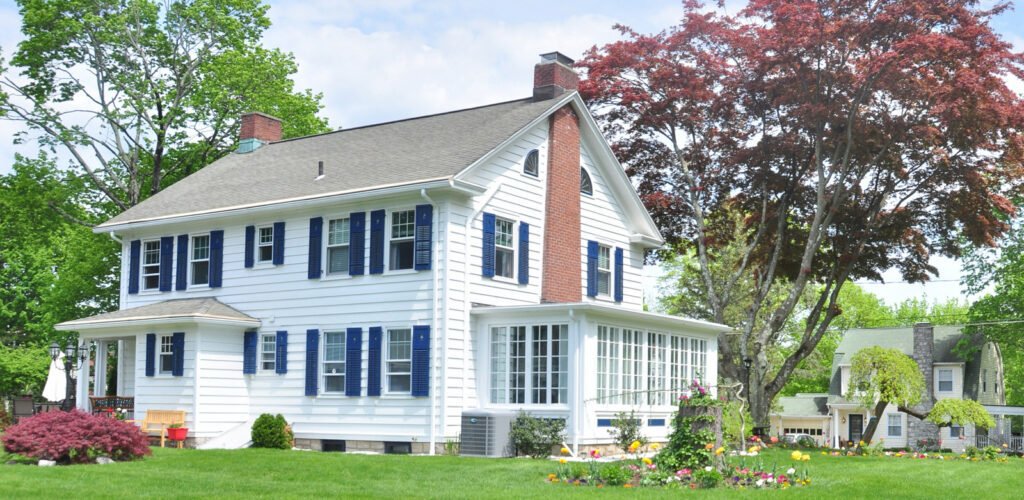How the Southern Oregon Climate Affects Your Exterior Paint
Key Takeaways
- How sun exposure causes fading, cracking, and chalking
- Why Southern Oregon’s wet winters wear down paint film and promote mildew
- The role temperature swings play in paint peeling and loss of adhesion
- How wildfire smoke and air pollutants can dull your home’s appearance
- Smart steps to extend the lifespan of your exterior paint
Southern Oregon’s weather is as beautiful as it is challenging. From blazing summer sunshine to wet winters and wildfire smoke, our homes face a wide range of conditions that directly affect how long exterior paint lasts — and how often you’ll need to repaint.
Whether you’re in Medford, Grants Pass, Ashland, or Eagle Point, understanding how the local climate impacts your exterior paint helps you make smart choices when it’s time to repaint or touch up your home.
Sun Exposure and Fading Paint
The Rogue Valley’s long, dry summers (see Weather Spark for details) mean months of UV exposure. Even high-quality paints will eventually fade when hit by intense sunlight day after day — especially on south- and west-facing walls.
How UV Rays Break Down Paint
Ultraviolet light breaks down the binders that hold pigment particles together. As these binders deteriorate, color fades unevenly, leaving your home looking washed out.
Preventing Sun Damage
Choose UV-resistant paints with high-quality acrylic resins
Opt for lighter, reflective colors that absorb less heat
Repaint sooner if you notice chalky residue on your siding — a common sign of UV degradation
(For more on this topic, see our related article on the best paints for exterior walls.)
Rain, Moisture, and Mildew Growth
Southern Oregon’s rainy winters create the perfect conditions for moisture intrusion. If your paint is aging or improperly sealed, water can seep behind the film and cause peeling or bubbling.
How Moisture Damages Paint
When water penetrates paint, it expands the wood beneath. As the surface dries, that expansion and contraction break the bond between paint layers, leading to flaking or cracking.
Protecting Your Home From Moisture
Keep gutters clear and drainage directed away from siding
Apply a mildew-resistant primer before painting
Avoid painting during wet or humid conditions — moisture trapped beneath new paint can cause blistering
For more details on how long a well-painted surface can last, see our article on how long exterior paint lasts.
Temperature Swings and Paint Adhesion
Southern Oregon’s large day-to-night temperature shifts — especially in fall and spring — create ongoing stress on painted surfaces.
How Expansion and Contraction Affect Paint
Wood, stucco, and even metal expand in the heat and contract in the cold. Over time, this movement can cause paint to lose flexibility, resulting in cracking or peeling.
Best Practices for Long-Term Durability
Use elastomeric or flexible paints that can handle temperature movement
Repaint during mild, stable weather (ideally 50–80°F)
Repair cracked caulking and joints before painting
Wildfire Smoke and Air Pollution
While the wildfire season doesn’t last all year, smoke and ash leave behind residue that can cling to paint, dull colors, and stain light finishes.
Effects of Smoke on Exterior Paint
Soot particles are slightly acidic, which can break down paint film over time. The residue can also trap moisture against the surface, accelerating wear.
How to Clean and Protect Against Smoke Damage
Rinse exterior walls with low-pressure water during smoky periods
Schedule professional exterior cleaning before painting or sealing
Consider paints with advanced stain-blocking properties for added protection
(You can learn more about proper washing timelines in our article on how long after power washing can you paint.)
Choosing Paint That Lasts in Southern Oregon
The key to keeping your home looking beautiful year-round is choosing the right paint for local conditions.
Look for premium exterior paints designed for UV resistance, moisture protection, and flexibility — all qualities that hold up well in Southern Oregon’s changing seasons.
When applied with proper surface prep, these paints typically last 8–12 years, though shady or north-facing walls often last even longer.
Hire a Local Painting Expert Who Understands the Climate
At Pacific Home Painting, we specialize in helping Southern Oregon homeowners select paints and finishes that withstand our region’s unique climate challenges. Whether you’re maintaining a newer home or restoring an older one, we’ll help you choose the right products and techniques for lasting beauty and protection.
Contact us today to get a free quote — and keep your home protected, season after season.
FAQs
Most homes in the Rogue Valley need repainting every 7–10 years, depending on sun exposure, paint quality, and surface material. South- and west-facing walls tend to fade faster due to stronger UV rays, while shaded sides may last longer.
Choose high-quality acrylic latex paints formulated for UV and moisture resistance. These paints remain flexible, preventing cracking during temperature swings, and they resist mildew growth during rainy seasons.
Yes — smoke and ash can dull the finish, stain lighter colors, and accelerate wear over time. Regular rinsing with a garden hose or light washing during smoky periods helps minimize buildup.
Late spring through early fall offers the best conditions — typically May through September — when temperatures are moderate and humidity is low. Avoid painting during heavy rain or when temperatures drop below 50°F.
Absolutely. A professional power wash removes dirt, mildew, and old residue so new paint can properly adhere. For more details, check out our related article on how long after power washing can you paint.
